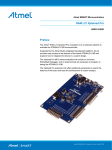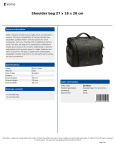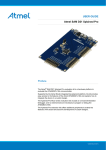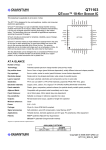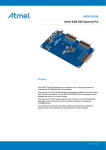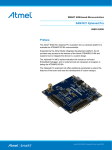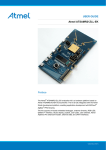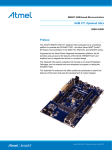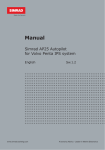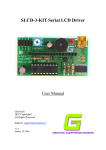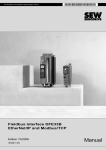Download Atmel SAM L21 Xplained Pro User Guide
Transcript
Atmel SMART Microcontrollers SAM L22 Xplained Pro USER GUIDE Preface ® The Atmel SAM L22 Xplained Pro evaluation kit is a hardware platform to evaluate the ATSAML22N18A microcontroller. Supported by the Atmel Studio integrated development platform, the kit provides easy access to the features of the Atmel ATSAML22N18A and explains how to integrate the device in a custom design. The Xplained Pro MCU series evaluation kits include an on-board Embedded Debugger, and no external tools are necessary to program or debug the ATSAML22N18A. The Xplained Pro extension kits offers additional peripherals to extend the features of the board and ease the development of custom designs. Atmel-42474A-SAM-L22-Xplained-Pro_User Guide-08/2015 Table of Contents Preface............................................................................................................................ 1 1. Introduction................................................................................................................ 4 1.1. 1.2. Features....................................................................................................................................... 4 Kit Overview................................................................................................................................. 4 2. Getting Started...........................................................................................................6 2.1. 2.2. Xplained Pro Quick Start.............................................................................................................. 6 Design Documentation and Relevant Links................................................................................. 6 3. Xplained Pro.............................................................................................................. 8 3.1. 3.2. 3.3. 3.4. 3.5. Embedded Debugger................................................................................................................... 8 Xplained Pro Analog Module (XAM).............................................................................................9 3.2.1. Overview........................................................................................................................9 3.2.2. EDBG Interface..............................................................................................................9 3.2.3. Sample Rate................................................................................................................ 10 3.2.4. Measurement Ranges and Accuracy...........................................................................10 Hardware Identification System..................................................................................................10 Power Sources........................................................................................................................... 11 Xplained Pro Headers and Connectors......................................................................................12 3.5.1. Xplained Pro Standard Extension Header................................................................... 12 3.5.2. Xplained Pro Segment LCD Connector....................................................................... 13 3.5.3. Xplained Pro Power Header........................................................................................ 14 4. Hardware User Guide.............................................................................................. 15 4.1. 4.2. 4.3. 4.4. Power Distribution...................................................................................................................... 15 Connectors................................................................................................................................. 15 4.2.1. Xplained Pro Standard Extension Headers................................................................. 16 4.2.2. Segment LCD Connector.............................................................................................19 4.2.3. Arduino Connector Footprint........................................................................................21 4.2.4. USB............................................................................................................................. 23 4.2.5. Current Measurement Header..................................................................................... 23 4.2.6. Cortex Debug Connector............................................................................................. 24 Peripherals................................................................................................................................. 24 4.3.1. Crystal..........................................................................................................................24 4.3.2. Mechanical Buttons..................................................................................................... 24 4.3.3. LED..............................................................................................................................25 4.3.4. QTouch Button............................................................................................................. 25 4.3.5. Backup Supercap........................................................................................................ 25 4.3.6. Crypto Device.............................................................................................................. 26 4.3.7. Tamper Detection.........................................................................................................26 Embedded Debugger Implementation........................................................................................27 4.4.1. Serial Wire Debug........................................................................................................27 4.4.2. Virtual COM Port..........................................................................................................27 4.4.3. Atmel Data Gateway Interface.....................................................................................27 Atmel SAM L22 Xplained Pro [USER GUIDE] Atmel-42474A-SAM-L22-Xplained-Pro_User Guide-08/2015 2 4.5. SAM L22 Xplained Pro XAM Configuration................................................................................28 4.6. Kit Modifications......................................................................................................................... 29 4.6.1. Operation at Other Voltages........................................................................................ 33 5. Hardware Revision History and Known Issues........................................................34 5.1. 5.2. Identifying Product ID and Revision........................................................................................... 34 Revision 2...................................................................................................................................34 6. Appendix..................................................................................................................35 6.1. Getting Started with IAR.............................................................................................................35 7. Document Revision History..................................................................................... 38 8. Evaluation Board/kit Important Notice..................................................................... 39 Atmel SAM L22 Xplained Pro [USER GUIDE] Atmel-42474A-SAM-L22-Xplained-Pro_User Guide-08/2015 3 1. Introduction 1.1. Features • • • • • • • • • • • • • • 1.2. ATSAML22N18A microcontroller One mechanical reset button One mechanical programmable button Xplained Pro segment LCD connector – Eight COM signals – Twenty seven SEG signals – Six touch signals ® One QTouch button One yellow user LED Backup super capacitor 32.768kHz crystal USB interface, device only Three Xplained Pro extension headers Embedded Debugger – Auto-ID for board identification in Atmel Studio – One yellow status LED – One green board power LED – Symbolic debug of complex data types icluding scope information – Programming and debugging, including power measurements – Data Gateway Interface: SPI, I2C, four GPIOs – Virtual COM port (CDC) Embedded current measurement circuitry, with Atmel Data Visualizer support for data visualization USB powered Supported with application examples in Atmel Software Framework Kit Overview The Atmel SAM L22 Xplained Pro evaluation kit is a hardware platform to evaluate the Atmel ATSAML22N18A. The kit offers a set of features that enables the ATSAML22N18A user to get started with the SAM L peripherals right away and to get an understanding of how to integrate the device in their own design. Atmel SAM L22 Xplained Pro [USER GUIDE] Atmel-42474A-SAM-L22-Xplained-Pro_User Guide-08/2015 4 Figure 1-1 SAM L22 Xplained Pro Evaluation Kit Overview Atmel SAM L22 Xplained Pro [USER GUIDE] Atmel-42474A-SAM-L22-Xplained-Pro_User Guide-08/2015 5 2. Getting Started 2.1. Xplained Pro Quick Start Three steps to start exploring the Atmel Xplained Pro platform: 1. Download Atmel Studio. 2. Launch Atmel Studio. 3. Connect a USB cable (Standard-A to Micro-B or Micro-AB) between the PC and the DEBUG USB port on the kit. When the Atmel SAM L22 Xplained Pro is connected to your computer for the first time, the operating system will perform a driver software installation. The driver file supports both 32- and 64-bit versions of ® ® ® Microsoft Windows XP, Windows Vista , Windows 7, and Windows 8. Once the Xplained Pro MCU board is powered the green power LED will be lit and Atmel Studio will auto detect which Xplained Pro MCU- and extension board(s) are connected. Atmel Studio will present relevant information like datasheets and kit documentation. The kit landing page in Atmel Studio also has the option to launch Atmel Software Framework (ASF) example applications for the kit. The SAM L22 device is programmed and debugged by the on-board Embedded Debugger and therefore no external programmer or debugger tool is needed. 2.2. Design Documentation and Relevant Links The following list contains links to the most relevant documents and software for the SAM L22 Xplained Pro. • • • • • • • • • • Xplained Pro products - Atmel Xplained Pro is a series of small-sized and easy-to-use evaluation kits for Atmel microcontrollers and other Atmel products. It consists of a series of low cost MCU boards for evaluation and demonstration of features and capabilities of different MCU families. Atmel Studio - Free Atmel IDE for development of C/C++ and assembler code for Atmel microcontrollers. Atmel sample store - Atmel sample store where you can order samples of devices. EDBG User Guide - User guide containing more information about the on-board Embedded Debugger. ® IAR Embedded Workbench for ARM - This is a commercial C/C++ compiler that is available for ARM. There is a 30 day evaluation version as well as a code size limited kick-start version available from their website. The code size limit is 16KB for devices with M0, M0+, and M1 cores and 32KB for devices with other cores. ® ® Atmel QTouch Library - QTouch Library for Atmel AVR and ARM - based microcontrollers. Atmel QTouch Composer - Tool for developing capacitive buttons, sliders, and wheels applications. Atmel Data Visualizer - Atmel Data Visualizer is a program used for processing and visualizing data. Data Visualizer can receive data from various sources such as the Embedded Debugger Data Gateway Interface found on Xplained Pro boards, and COM ports. Segment LCD1 Xplained Pro - Segment LCD1 Xplained Pro is a segment LCD Xplained Pro extension with 96 segments that uses 4 COM and 24 SEG signals. An Xplained Pro MCU board with a Xplained Pro segment LCD connector is required to use the kit. Design Documentation - Package containing CAD source, schematics, BOM, assembly drawings, 3D plots, layer plots etc. Atmel SAM L22 Xplained Pro [USER GUIDE] Atmel-42474A-SAM-L22-Xplained-Pro_User Guide-08/2015 6 • Hardware Users Guide in PDF format - PDF version of this User Guide. Atmel SAM L22 Xplained Pro [USER GUIDE] Atmel-42474A-SAM-L22-Xplained-Pro_User Guide-08/2015 7 3. Xplained Pro Xplained Pro is an evaluation platform that provides the full Atmel microcontroller experience. The platform consists of a series of Microcontroller (MCU) boards and extension boards which are integrated with Atmel Studio, have Atmel Software Framework (ASF) drivers and demo code, support data streaming, and more. Xplained Pro MCU boards support a wide range of Xplained Pro extension boards which are connected through a set of standardized headers and connectors. Each extension board has an identification (ID) chip to uniquely identify which boards are connected to an Xplained Pro MCU board. This information is used to present relevant user guides, application notes, datasheets, and example code through Atmel Studio. 3.1. Embedded Debugger The SAM L22 Xplained Pro contains the Atmel Embedded Debugger (EDBG) for on-board debugging. The EDBG is a composite USB device of three interfaces; a debugger, Virtual COM Port, and a Data Gateway Interface (DGI). Together with Atmel Studio, the EDBG debugger interface can program and debug the ATSAML22N18A. On SAM L22 Xplained Pro, the SWD interface is connected between the EDBG and the ATSAML22N18A. The Virtual COM Port is connected to a UART on the ATSAML22N18A and provides an easy way to communicate with the target application through terminal software. It offers variable baud rate, parity, and stop bit settings. Note that the settings on the ATSAML22N18A must match the settings given in the terminal software. Note: If not set automatically, data terminal ready (DTR) must be set in the terminal software. The DGI consists of several physical interfaces for communication with the host computer. Communication over the interfaces is bidirectional. It can be used to send events and values from the ATSAML22N18A or as a generic printf-style data channel. Traffic over the interfaces can be timestamped on the EDBG for more accurate tracing of events. Note that timestamping imposes an overhead that reduces maximal throughput. Atmel Data Visualizer is used to send and receive data through DGI. The EDBG controls two LEDs on SAM L22 Xplained Pro; a power LED and a status LED. Table 3-1 EDBG LED Control on page 8 shows how the LEDs are controlled in different operation modes. Table 3-1 EDBG LED Control Operation Mode Power LED Status LED Normal operation Power LED is lit when power is applied to the board. Activity indicator, LED flashes when any communication happens to the EDBG. Bootloader mode (idle) The power LED and the status LED blinks simultaneously. Bootloader mode (firmware upgrade) The power LED and the status LED blinks in an alternating pattern. For further documentation on the EDBG, see the EDBG User Guide. Atmel SAM L22 Xplained Pro [USER GUIDE] Atmel-42474A-SAM-L22-Xplained-Pro_User Guide-08/2015 8 3.2. Xplained Pro Analog Module (XAM) 3.2.1. Overview Current output The Xplained Pro Analog Module (XAM) extends the embedded debugger with high dynamic range current measurement. This enables power profiling of the target system. Calibration circuitry GPIO(s) Control MCU Sync GPIO I2C Calibration ON/OFF GPIO SPI EDBG Clock sync Range selection voltage reference 2.7V SWD AREF 100 Ohm 100 mOhm Pre-amplifier 2x ADC0 ADC1 20x20x S&H ADC 16x GND Active filter with gain Current input GPIO Xplained Pro Analog Module (XAM) The XAM consists of: • • • • Calibration circuitry Voltage reference Analog frontend – Shunt resistors with a range selection switch – Pre-amplifier – Two active filters with gain Control MCU – Analog to digital converter – Signal processing – Control/communication interface to the EDBG The current measurement frontend is a high side shunt measurement with a pre-amplifier and a second active filter stage with gain. The wide dynamic range is achieved by four measurement ranges which are defined by two shunts and the two parallel second stage active filters with gain. 3.2.2. EDBG Interface The Xplained Pro Analog Module (XAM) is connected to the EDBG with the following interfaces: • • I2C: This is used to control and configure the XAM SPI: Current measurement data is streamed to the EDBG via this interface. This is a one-way data transfer channel from the XAM to the EDBG Atmel SAM L22 Xplained Pro [USER GUIDE] Atmel-42474A-SAM-L22-Xplained-Pro_User Guide-08/2015 9 • • • • 3.2.3. SWD: The MCU in the XAM is programmed via SWD from the EDBG GPIO: At least one GPIO that is connected to the EDBG from the target MCU is also connected to the current measurement unit to enable the user to sync current measurements with his application Clock sync: Synchronization signal to synchronize ADC measurements with EDBG Reference clock: Reference clock for the XAM Sample Rate The raw sampling rate of the Xplained Pro analog module (XAM) is up to 250kHz and with the default averaging configuration (average of 16 samples) the actual output of the XAM is 16.67kSPS (note that the XAM output sample rate is not an integer fraction of the raw sampling). 3.2.4. Measurement Ranges and Accuracy The Xplained Pro analog module has four measurement ranges. These are defined by two shunt resistors and two gain stages. Measurement range Hardware Resolution Accuracy Comments Range 1 Low current shunt and high gain stage 20nA 1 LSB ±1% Below 1μA the error will increase. Typical error for 300nA is 1 LSB ± 10% Range 2 Low current shunt and low gain stage 150nA 1 LSB ±1% Range 3 High current shunt and high gain stage 10μA 1 LSB ±1% Range 4 High current shunt and low gain stage 100μA 1 LSB ±1% Above 100mA the error will increase to 1 LSB ±5% at 400mA. Maximum current is 400mA The ranges are switched automatically by the XAM to achieve best measurement results and the currently active range is visualized in the Atmel Data Visualizer frontend tool. The maximum voltage drop over the shunt resistor is 100mV and the XAM will switch the range automatically before this limit is reached. 3.3. Hardware Identification System ™ All Xplained Pro compatible extension boards have an Atmel ATSHA204 CryptoAuthentication chip mounted. This chip contains information that identifies the extension with its name and some extra data. When an Xplained Pro extension is connected to an Xplained Pro MCU board the information is read and sent to Atmel Studio. The Atmel Kits extension, installed with Atmel Studio, will give relevant information, code examples, and links to relevant documents. Table 3-2 Xplained Pro ID Chip Content on page 10 shows the data fields stored in the ID chip with example content. Table 3-2 Xplained Pro ID Chip Content Data field Data type Example content Manufacturer ASCII string Atmel'\0' Product Name ASCII string Segment LCD1 Xplained Pro'\0' Atmel SAM L22 Xplained Pro [USER GUIDE] Atmel-42474A-SAM-L22-Xplained-Pro_User Guide-08/2015 10 3.4. Data field Data type Example content Product Revision ASCII string 02'\0' Product Serial Number ASCII string 1774020200000010’\0’ Minimum Voltage [mV] uint16_t 3000 Maximum Voltage [mV] uint16_t 3600 Maximum Current [mA] uint16_t 30 Power Sources The SAM L22 Xplained Pro kit can be powered by several power sources listed in Table 3-3 Power Sources for SAM L22 Xplained Pro on page 11. Table 3-3 Power Sources for SAM L22 Xplained Pro Power input Voltage requirements Current requirements Connector marking External power 5V ±2% (±100mV) for USB host operation. 4.3V to 5.5V if USB host operation is not required. Recommended minimum is 1A to be able to provide enough current for connected USB devices and the board itself. Recommended maximum is 2A due to the input protection maximum current specification. PWR Embedded debugger USB 4.4V to 5.25V (according 500mA (according to to USB spec.) USB spec.) DEBUG USB Target USB 4.4V to 5.25V (according 500mA (according to to USB spec.) USB spec.) TARGET USB The kit will automatically detect which power sources are available and choose which one to use according to the following priority: 1. 2. 3. External power. Embedded Debugger USB. Target USB. Info: External power is required when 500mA from a USB connector is not enough to power the board with possible extension boards. A connected USB device in a USB host application might easily exceed this limit. Atmel SAM L22 Xplained Pro [USER GUIDE] Atmel-42474A-SAM-L22-Xplained-Pro_User Guide-08/2015 11 3.5. Xplained Pro Headers and Connectors 3.5.1. Xplained Pro Standard Extension Header All Xplained Pro kits have one or more dual row, 20-pin, 100mil extension header. Xplained Pro MCU boards have male headers, while Xplained Pro extensions have their female counterparts. Note that all pins are not always connected. All connected pins follow the defined pin-out description in Table 3-4 Xplained Pro Standard Extension Header on page 12. The extension headers can be used to connect a variety of Xplained Pro extensions to Xplained Pro MCU boards or to access the pins of the target MCU on Xplained Pro MCU boards directly. Table 3-4 Xplained Pro Standard Extension Header Pin number Name Description 1 ID Communication line to the ID chip on an extension board 2 GND Ground 3 ADC(+) Analog to digital converter, alternatively positive part of differential ADC 4 ADC(-) Analog to digital converter, alternatively negative part of differential ADC 5 GPIO1 General purpose I/O 6 GPIO2 General purpose I/O 7 PWM(+) Pulse width modulation, alternatively positive part of differential PWM 8 PWM(-) Pulse width modulation, alternatively negative part of differential PWM 9 IRQ/GPIO Interrupt request line and/or general purpose I/O 10 SPI_SS_B/ GPIO Slave select for SPI and/or general purpose I/O 11 I2C_SDA Data line for I2C interface. Always implemented, bus type. 12 I2C_SCL Clock line for I2C interface. Always implemented, bus type. 13 UART_RX Receiver line of target device UART 14 UART_TX Transmitter line of target device UART 15 SPI_SS_A Slave select for SPI. Should preferably be unique. 16 SPI_MOSI Master out slave in line of serial peripheral interface. Always implemented, bus type. 17 SPI_MISO Master in slave out line of serial peripheral interface. Always implemented, bus type. 18 SPI_SCK Clock for serial peripheral interface. Always implemented, bus type. 19 GND Ground 20 VCC Power for extension board Atmel SAM L22 Xplained Pro [USER GUIDE] Atmel-42474A-SAM-L22-Xplained-Pro_User Guide-08/2015 12 3.5.2. Xplained Pro Segment LCD Connector Xplained Pro MCU boards that have a microcontroller that supports segment LCDs can implement a 51pin segment LCD extension connector. This connector is implemented with HIROSE DF-9 series. Xplained Pro MCU boards use the male version DF9-51P-1V(69) and Xplained Pro extension boards use the female counterpart DF9-51S-1V(69). The connector has a standardized pin-out as shown in Table 3-5 Xplained Pro Segment LCD Connector on page 13. Note: All pins are not connected on all Xplained Pro MCU boards, it depends on how many segments and common terminals the target MCU supports. Pin 37, 38, 39, 40, 41 and 42 can alternatively be used for QTouch signals. When they are used for touch they should not be used for display segments. Table 3-5 Xplained Pro Segment LCD Connector Description Function Pin Pin Function Description Common terminal 3 COM3 1 2 COM2 Common terminal 2 Common terminal 1 COM1 3 4 COM0 Common terminal 0 Segment 0 SEG0 5 6 SEG1 Segment 1 Segment 2 SEG2 7 8 SEG3 Segment 3 Segment 4 SEG4 9 10 SEG5 Segment 5 Segment 6 SEG6 11 12 SEG7 Segment 7 Segment 8 SEG8 13 14 SEG9 Segment 9 Segment 10 SEG10 15 16 SEG11 Segment 11 Segment 12 SEG12 17 18 SEG13 Segment 13 Segment 14 SEG14 19 20 SEG15 Segment 15 Segment 16 SEG16 21 22 SEG17 Segment 17 Segment 18 SEG18 23 24 SEG19 Segment 19 Segment 20 SEG20 25 26 SEG21 Segment 21 Segment 22 SEG22 27 28 SEG23 Segment 23 Segment 24 SEG24 29 30 SEG25 Segment 25 Segment 26 SEG26 31 32 SEG27 Segment 27 Segment 28 SEG28 33 34 SEG29 Segment 29 Segment 30 SEG30 35 36 SEG31 Segment 31 Segment 32 / QTouch X-line 2 SEG32 / QT_X2 37 38 SEG33 / QT_Y2 Segment 33 / QTouch Y-line 2 Segment 34 / QTouch X-line 1 SEG34 / QT_X1 39 40 SEG35 / QT_Y1 Segment 35 / QTouch Y-line 1 Segment 36 / QTouch X-line 0 SEG36 / QT_X0 41 42 SEG37 / QT_Y0 Segment 37 / QTouch Y-line 0 Atmel SAM L22 Xplained Pro [USER GUIDE] Atmel-42474A-SAM-L22-Xplained-Pro_User Guide-08/2015 13 3.5.3. Description Function Pin Pin Function Description Common terminal 4 COM4 43 44 COM5 Common terminal 5 Common terminal 6 COM6 45 46 COM7 Common terminal 6 Backlight anode Backlight V+ 47 48 Backlight V- Backlight Cathode Backlight control Backlight CTRL 49 50 ID Xplained Pro ID Ground GND 51 Xplained Pro Power Header The power header can be used to connect external power to the SAM L22 Xplained Pro kit. The kit will automatically detect and switch to any external power if supplied. The power header can also be used as supply for external peripherals or extension boards. Care must be taken not to exceed the total current limitation of the on-board regulator when using the 3.3V pin. Table 3-6 Xplained Pro Power Header Pin number Pin name Description 1 VEXT_P5V0 External 5V input 2 GND Ground 3 VCC_P5V0 Unregulated 5V (output, derived from one of the input sources) 4 VCC_P3V3 Regulated 3.3V (output, used as main power supply for the kit) Atmel SAM L22 Xplained Pro [USER GUIDE] Atmel-42474A-SAM-L22-Xplained-Pro_User Guide-08/2015 14 4. Hardware User Guide 4.1. Power Distribution SAM L22 Xplained Pro has three power sources, EDBG USB, Target USB and/or external 5.0V, the kit will automatically select a source to draw power from. The kit has two on-board 3.3V voltage regulators, one for the EDBG and XAM and one for the ATSAML22N18A and other peripherals. An on board supercap (47mF) is charged to 3.3V from the target 3.3V net. The supercap is connected to PB03 (VBAT) through a selection header and is intended for backup use in sleep modes. Figure 4-1 Power Supply Block Diagram VCC_P5V0 External 5V input Regulator 3.3V EDBG & XAM Auto mux disable EDBG USB VCC_P3V3 Auto mux with current limit Regulator 3.3V Power Measurement Select VCC_MCU Jumper VBAT SAML22N18 Select Target USB Power converter Supercap Power consumer Power source Peripherals Power switch VCC_TARGET Related Links Power Sources on page 11 4.2. Connectors The following sections describes the implementation of the relevant connectors and headers on SAM L22 Xplained Pro and their connection to the ATSAML22N18A. The tables of connections in the sections also describes which signals are shared between the headers and on-board functionality.Figure 4-2 SAM L22 Xplained Pro Connector Overview on page 16 shows all available connectors and jumpers on SAM L22 Xplained Pro. Atmel SAM L22 Xplained Pro [USER GUIDE] Atmel-42474A-SAM-L22-Xplained-Pro_User Guide-08/2015 15 Figure 4-2 SAM L22 Xplained Pro Connector Overview 4.2.1. Xplained Pro Standard Extension Headers The SAM L22 Xplained Pro headers EXT1, EXT2, and EXT3 offers access to the I/O of the microcontroller in order to expand the board e.g. by connecting extensions to the board. These headers are based on the standard extension header specified in Table 3-4 Xplained Pro Standard Extension Header on page 12 . The headers have a pitch of 2.54mm. Atmel SAM L22 Xplained Pro [USER GUIDE] Atmel-42474A-SAM-L22-Xplained-Pro_User Guide-08/2015 16 Table 4-1 Extension Header EXT1 EXT1 pin SAM L22 Function pin Shared functionality 1 [ID] - - Communication line to the ID chip on an extension board. 2 [GND] - - Ground. 3 [ADC(+)] PA02 AIN[0] - 4 [ADC(-)] PA03 AIN[1] Shield 5 [GPIO1] PA20 GPIO (RTS) - 6 [GPIO2] PA21 GPIO (CTS) - 7 [PWM(+)] PB08 TC0/WO[0] - 8 [PWM(-)] PB09 TC0/WO[1] - 9 [IRQ/GPIO] PC02 IRQ10/GPIO - 10 [SPI_SS_B/GPIO] PC03 GPIO - 11 [TWI_SDA] PB30 SERCOM5 PAD[0] I²C SDA EXT2, EXT3, Shield, Crypto, and EDBG I²C 12 [TWI_SCL] PB31 SERCOM5 PAD[1] I²C SCL EXT2, EXT3, Shield, Crypto, and EDBG I²C 13 [USART_RX] PA23 SERCOM2 PAD[1] UART RX - 14 [USART_TX] PA22 SERCOM2 PAD[0] UART TX - 15 [SPI_SS_A] PB21 SERCOM3 PAD[1] SPI SS - 16 [SPI_MOSI] PB00 SERCOM3 PAD[2] SPI MOSI - 17 [SPI_MISO] PB02 SERCOM3 PAD[0] SPI MISO - 18 [SPI_SCK] PB01 SERCOM3 PAD[3] SPI SCK - 19 [GND] - - Ground. 20 [VCC] - - Power for extension board. Table 4-2 Extension Header EXT2 EXT2 pin SAM L22 Function pin Shared functionality 1 [ID] - - Communication line to the ID chip on an extension board. 2 [GND] - - Ground. 3 [ADC(+)] PA04 AIN[4] Shield 4 [ADC(-)] PA05 AIN[5] Shield 5 [GPIO1] PB04 GPIO EDBG GPIO0 and SLCD Atmel SAM L22 Xplained Pro [USER GUIDE] Atmel-42474A-SAM-L22-Xplained-Pro_User Guide-08/2015 17 EXT2 pin SAM L22 Function pin Shared functionality 6 [GPIO2] PB05 GPIO EDBG GPIO1 and SLCD 7 [PWM(+)] PC28 TCC0/WO[4] SLCD 8 [PWM(-)] PA27 TCC0/WO[5] SLCD 9 [IRQ/GPIO] PB06 IRQ6/GPIO Shield and EDBG GPIO2 10 [SPI_SS_B/GPIO] PB07 GPIO Shield and EDBG GPIO3 11 [TWI_SDA] PB30 SERCOM5 PAD[0] I²C SDA EXT1, EXT3, Shield, Crypto, and EDBG I²C 12 [TWI_SCL] PB31 SERCOM5 PAD[1] I²C SCL EXT1, EXT3, Shield, Crypto, and EDBG I²C 13 [USART_RX] PA13 SERCOM3 PAD[1] UART RX - 14 [USART_TX] PA12 SERCOM3 PAD[0] UART TX - 15 [SPI_SS_A] PA17 SERCOM1 PAD[1] SPI SS - 16 [SPI_MOSI] PA18 SERCOM1 PAD[2] SPI MOSI - 17 [SPI_MISO] PA16 SERCOM1 PAD[0] SPI MISO - 18 [SPI_SCK] PA19 SERCOM1 PAD[3] SPI SCK - 19 [GND] - - Ground. 20 [VCC] - - Power for extension board. Table 4-3 Extension Header EXT3 EXT3 pin SAM L22 Function pin Shared functionality 1 [ID] - - Communication line to the ID chip on an extension board. 2 [GND] - - Ground. 3 [ADC(+)] PA06 AIN[8] SLCD 4 [ADC(-)] PA07 AIN[9] SLCD 5 [GPIO1] PC16 GPIO SLCD 6 [GPIO2] PC17 GPIO SLCD 7 [PWM(+)] PB16 TC2/WO[0] SLCD 8 [PWM(-)] PB17 TC2/WO[1] SLCD 9 [IRQ/GPIO] PB18 IRQ2/GPIO SLCD 10 [SPI_SS_B/GPIO] PB19 GPIO SLCD 11 [TWI_SDA] SERCOM5 PAD[0] I²C SDA EXT1, EXT2, Shield, Crypto, and EDBG I²C PB30 Atmel SAM L22 Xplained Pro [USER GUIDE] Atmel-42474A-SAM-L22-Xplained-Pro_User Guide-08/2015 18 4.2.2. EXT3 pin SAM L22 Function pin Shared functionality 12 [TWI_SCL] PB31 SERCOM5 PAD[1] I²C SCL EXT1, EXT2, Shield, Crypto, and EDBG I²C 13 [USART_RX] PA15 SERCOM4 PAD[3] UART RX SLCD 14 [USART_TX] PA14 SERCOM4 PAD[2] UART TX SLCD 15 [SPI_SS_A] PA09 SERCOM0 PAD[1] SPI SS SLCD 16 [SPI_MOSI] PA10 SERCOM0 PAD[2] SPI MOSI SLCD 17 [SPI_MISO] PA08 SERCOM0 PAD[0] SPI MISO SLCD 18 [SPI_SCK] PA11 SERCOM0 PAD[3] SPI SCK SLCD 19 [GND] - - Ground. 20 [VCC] - - Power for extension board. Segment LCD Connector Extension connector EXT5 is a special connector for segment LCD displays. SAM L22 Xplained Pro implements one segment LCD extension connector for Xplained Pro extensions and supports up to eight COM, twenty seven SEG and six touch signals. The connector has a standardized pin-out as shown in Table 3-5 Xplained Pro Segment LCD Connector on page 13. Table 4-4 Segment LCD Display Connector EXT5 EXT5 Pin SAM L22 pin Function Shared functionality 1 [COM3] PC06 SLCD/ LP[9] Shield 2 [COM2] PC05 SLCD/ LP[8] Shield 3 [COM1] PA07 SLCD/ LP[7] Shield and EXT3 4 [COM0] PA06 SLCD/ LP[6] Shield and EXT3 5 [SEG0] PA11 SLCD/ LP[14] EXT3 6 [SEG1] PC08 SLCD/ LP[15] 7 [SEG2] PC09 SLCD/ LP[16] 8 [SEG3] PC10 SLCD/ LP[17] 9 [SEG4] PC11 SLCD/ LP[18] Shield and Shield (2) 10 [SEG5] PC12 SLCD/ LP[19] Shield and Shield (2) 11 [SEG6] PC13 SLCD/ LP[20] Shield and Shield (2) 12 [SEG7] PB11 SLCD/ LP[21] Shield 13 [SEG8] PB12 SLCD/ LP[22] Shield 14 [SEG9] PB13 SLCD/ LP[23] Shield 15 [SEG10] PB14 SLCD/ LP[24] Shield 16 [SEG11] PB15 SLCD/ LP[25] Shield Atmel SAM L22 Xplained Pro [USER GUIDE] Atmel-42474A-SAM-L22-Xplained-Pro_User Guide-08/2015 19 EXT5 Pin SAM L22 pin Function Shared functionality 17 [SEG12] PC14 SLCD/ LP[26] Shield 18 [SEG13] PC15 SLCD/ LP[27] Shield 19 [SEG14] PA14 SLCD/ LP[30] EXT3 20 [SEG15] PA15 SLCD/ LP[31] EXT3 21 [SEG16] PC16 SLCD/ LP[36] EXT3 22 [SEG17] PC17 SLCD/ LP[37] EXT3 23 [SEG18] PC18 SLCD/ LP[38] 24 [SEG19] PC19 SLCD/ LP[39] 25 [SEG20] PC20 SLCD/ LP[40] 26 [SEG21] PC21 SLCD/ LP[41] Crypto 27 [SEG22] PB16 SLCD/ LP[42] EXT3 28 [SEG23] PB17 SLCD/ LP[43] EXT3 29 [SEG24] PB18 SLCD/ LP[44] EXT3 30 [SEG25] PB19 SLCD/ LP[45] EXT3 31 [SEG26] PB20 SLCD/ LP[46] Shield 32 [SEG27] - 33 [SEG28] - 34 [SEG29] - 35 [SEG30] - 36 [SEG31] - 37 [SEG32/ QT_X2 ] PC01 PTC/X[5] User SW0 38 [SEG33/ QT_Y2] PB05 PTC/X[11] EDBG GPIO1 and EXT2 39 [SEG34/ QT_X1] PC00 PTC/X[4] QTBTN1 40 [SEG35/ QT_Y1] PB04 PTC/Y[10] EDBG GPIO0 and EXT2 41 [SEG36/ QT_X0] PC28 PTC/X[20] EXT2 42 [SEG37/ QT_Y0] PA27 PTC/Y[21] EXT2 43 [COM4] PC07 SLCD/ LP[10] Shield 44 [COM5] PA08 SLCD/ LP[11] EXT3 45 [COM6] PA09 SLCD/ LP[12] EXT3 Atmel SAM L22 Xplained Pro [USER GUIDE] Atmel-42474A-SAM-L22-Xplained-Pro_User Guide-08/2015 20 4.2.3. EXT5 Pin SAM L22 pin Function Shared functionality 46 [COM7] PA10 SLCD/ LP[13] EXT3 47 [Backlight V +] - VCC_P3V3 48 [Backlight V-] - GND 49 [Backlight CTRL] PC27 TC3/WO[1] 50 [ID] - Xplained Pro ID Communication line to ID chip on extension board. 51 [GND] - GND User LED0 Arduino Connector Footprint SAM L22 Xplained Pro implements Arduino shield connectors footprints based on the Arduino Uno. All references to Arduino pin names are taken from the official Arduino schematics of the Arduino Uno. Info: Note that all pins do not have the exact same functionality as on the Arduino Uno on the shield connectors, each shield should be checked for compatibility before it is connected. Table 4-5 J902 - Power Pin on J902 SAM L22 pin Arduino pin name Function Shared functionality 1 - RFU - - 2 - IOREF VCC_TARGET_P3 V3 3 RESETN RESET TARGET_RESET 4 - 3.3V VCC_TARGET_P3 V3 5 - 5V VCC_P5V0 - 6 - GND GND - 7 - GND GND - 8 - VIN VCC_EXT_P5V0 - - Table 4-6 J903 - Analog Pin on J903 SAM L22 pin Arduino pin name Function Shared functionality 1 PB06 ADC0 AIN14 EXT2 and EDBG GPIO2 2 PB07 ADC1 AIN15 EXT2 and EDBG GPIO3 Atmel SAM L22 Xplained Pro [USER GUIDE] Atmel-42474A-SAM-L22-Xplained-Pro_User Guide-08/2015 21 Pin on J903 SAM L22 pin Arduino pin name Function Shared functionality 3 PA04 ADC2 AIN4 EXT2 4 PA05 ADC3 AIN5 EXT2 5 PA06 ADC4 AIN6 EXT3 and SLCD 6 PA07 ADC5 AIN7 EXT3 and SLCD Table 4-7 J904 - Digital Low Pin on J904 SAM L22 pin Arduino pin name Function Shared functionality 1 PB13 D0 / RX0 SERCOM3 PAD[1] UART RX SLCD 2 PB12 D1 / TX0 SERCOM3 PAD[0] UART TX SLCD 3 PB11 D2 GPIO SLCD 4 PB14 D3 GPIO SLCD 5 PB15 D4 GPIO SLCD 6 PC14 D5 GPIO SLCD 7 PC15 D6 GPIO SLCD 8 PB20 D7 GPIO SLCD Table 4-8 J901 - Digital High Pin on J901 SAM L22 pin Arduino pin name Function Shared functionality 1 PC05 D8 GPIO SLCD 2 PC06 D9 GPIO SLCD 3 PC07 D10 / SPI-SS GPIO SLCD 4 PC12 D11 / SPI-MOSI SERCOM1 PAD[0] SPI MOSI SLCD and Shield 5 PC11 D12 / SPI-MISO SERCOM1 PAD[3] SPI MISO SLCD and Shield 6 PC13 D13 / SPI-SCK SERCOM1 PAD[1] SPI SCK SLCD and Shield 7 - GND - - 8 PA03 AREF ADC / DAC VREFA EXT1 Atmel SAM L22 Xplained Pro [USER GUIDE] Atmel-42474A-SAM-L22-Xplained-Pro_User Guide-08/2015 22 Pin on J901 SAM L22 pin Arduino pin name Function Shared functionality 9 PB30 SDA SERCOM5 PAD[0] I²C SDA EXT1, EXT2, EXT3, Crypto, and EDBG I²C 10 PB31 SCL SERCOM5 PAD[1] I²C SCL EXT1, EXT2, EXT3, Crypto, and EDBG I²C Pin on J900 SAM L22 pin Arduino pin name Function Shared functionality 1 PC11 MISO SERCOM1 PAD[3] SPI MISO SLCD and Shield 2 - 5V VCC_P5V0 - 3 PC13 SCK SERCOM1 PAD[1] SPI SCK SLCD and Shield 4 PC12 MOSI SERCOM1 PAD[0] SPI MOSI SLCD and Shield 5 RESETN RESET TARGET_RESET - 6 - GND GND - Table 4-9 J900 - SPI 4.2.4. USB The SAM L22 Xplained Pro has a Micro-USB connector for use with the SAM L22 USB module labeled as TARGET USB on the kit. To be able to detect when a target USB cable is connected in self-powered mode, a GPIO is used to detect the VBUS voltage on the connector. Table 4-10 USB Connections 4.2.5. SAM L22 pin USB function PC26 VBUS Detection PA24 USB D- PA25 USB D+ Current Measurement Header An angled 1x2, 100mil pin-header marked with MCU current measurement is located at the upper edge of the SAM L22 Xplained Pro. All power to the ATSAML22N18A is routed through this header. To measure the power consumption of the device remove the jumper and replace it with an ammeter. Caution: Removing the jumper from the pin-header while the kit is powered may cause the ATSAML22N18A to be powered through its I/O pins. This may cause permanent damage to the device. Atmel SAM L22 Xplained Pro [USER GUIDE] Atmel-42474A-SAM-L22-Xplained-Pro_User Guide-08/2015 23 4.2.6. Cortex Debug Connector ® SAM L22 Xplained Pro has a 10-pin 50-mil Cortex Debug Connector that can be used to attach external debuggers to the ATSAML22N18A. Table 4-11 Cortex Debug Connector Cortex Debug Connector pin Pin / Net Function Shared functionality 1 VCC_TARGET_P3V3 ATSAML22N18A voltage 2 PA31 SWD data signal 3 GND Ground 4 PA30 SWD clock signal 5 GND Ground 6 - - 7 - - 8 - - 9 GND Ground 10 RESETN Target reset signal EDBG SWD EDBG SWD 4.3. Peripherals 4.3.1. Crystal The SAM L22 Xplained Pro kit contains a 32.768kHz crystal that can be used as clock source for the SAM L22 device. The crystal has a cut-strap next to it that can be used to measure the oscillator safety factor. This is done by cutting the strap and adding a resistor across the strap. More information about oscillator allowance and safety factor can be found in appnote AVR41001. Table 4-12 External 32.768kHz Crystal 4.3.2. SAM L22 pin Function PA00 XIN32 PA01 XOUT32 Mechanical Buttons SAM L22 Xplained Pro contains two mechanical buttons. One button is the RESET button connected to the SAM L22 reset line and the other is a generic user configurable button. When a button is pressed it will drive the I/O line to GND. Info: There is no pull-up resistor connected to the generic user button. Remember to enable the internal pull-up in the SAM L22 to use the button. Atmel SAM L22 Xplained Pro [USER GUIDE] Atmel-42474A-SAM-L22-Xplained-Pro_User Guide-08/2015 24 Table 4-13 Mechanical Buttons 4.3.3. SAM L22 pin Silkscreen text RESET RESET PC01 SW0 Shared functionality SLCD LED There is one yellow LED available on the SAM L22 Xplained Pro board that can be turned on and off. The LED can be activated by driving the connected I/O line to GND. Table 4-14 LED Connection 4.3.4. SAM L22 pin Function Shared functionality PC27 Yellow LED0 SLCD QTouch Button There is one self capacitance button available on the SAM L22 Xplained Pro board that can be used as I/O. This QTouch button is intended to be driven by the built-in Peripheral Touch Controller (PTC) of the device. Info: To get started with QTouch refer to Atmel QTouch Library and Atmel QTouch Composer. Table 4-15 QTouch Connection 4.3.5. SAM L22 pin Silkscreen text Shared functionality PC00 QT BTN1 SLCD Backup Supercap The SAM L22 Xplained Pro has a backup super capacitor for use with the SAM L22 backup module. The supercap can be connected to the device by placing a jumper over pin 1-2 on the 3-pin VBAT SELECT header. By default the jumper is placed over pin 2-3 to select the board power supply. This configuration is selected to avoid draining the supercap and can be used during development. Due to the high capacitive load represented by the supercap, a 220Ω limiting resistor is added to reduce inrush current. The charging supply is the targets main supply and a low-power opamp is is used for disconnecting the charger input when removing power. This is added to avoid a current leak back to the main supply from the supercap when power is removed. A full charge of the supercap from empty will take approximately 45 seconds and can supply the target device in backup mode with ULP running for up to 24 hours. Other modes are not characherized, but will reduce the available time in backup mode respectively. For more information about the current consumption in other modes, refer to the electrical characteristics chapter in the SAM L22 datasheet. Atmel SAM L22 Xplained Pro [USER GUIDE] Atmel-42474A-SAM-L22-Xplained-Pro_User Guide-08/2015 25 Table 4-16 VBAT SELECT Header 4.3.6. VBAT SELECT pin Function 1 Power from super capacitor (47mF) 2 PB03/VBAT pin on SAM L22 3 Power from board supply Crypto Device Several of the Atmel security devices requires only an I2C interface to work, and they share the same packages and pinouts. SAM L22 Xplained Pro implements a DFN8 footprint for these devices so the user may test the mounted ATAES132A device or solder in other CryptoAuthentication devices. Table 4-17 Crypto Device Connections on page 26 shows all the connections between the ATAES132A and the ATSAML22N18A. Table 4-17 Crypto Device Connections 4.3.7. ATAES132A pin SAM L22 pin Function Shared functionality 1 [NC] - GND - 2 [AUTHO] PC21 GPIO/EIC SLCD 3 [NC] - 4 [GND] - GND - 5 [SDA] PB30 SERCOM5 PAD[0] I²C SDA EXT1, EXT2, EXT3, Shield, and EDBG I²C 6 [SCL] PB31 SERCOM5 PAD[1] I²C SCL EXT1, EXT2, EXT3, Shield, and EDBG I²C 7 [NC] - 8 [VCC] - VCC_TARGET_P3V3 - PAD - GND - - - Tamper Detection The ATSAML22N18A supports up to five selectable polarity external inputs and one output that can be used for tamper detection. When tamper is detected a time stamp is logged and an interrupt is raised. The output pin can be used for PCB active layer detection, when enabled a bit pattern is applied to the output pin, if this pattern is not detected at an input pin a tamper is detected. PC01, one of the inputs, is connected to the on-board user button. PB01, the tamper output, is connected to EXT1 together with several tamper inputs. Pressing the user button or using a jumper on EXT1 between PB01 and an input can emulate for example the chassis of a product being opened or a modification to a PCB. For more details about how the tamper functionality works see the SAM L22 data sheet. Atmel SAM L22 Xplained Pro [USER GUIDE] Atmel-42474A-SAM-L22-Xplained-Pro_User Guide-08/2015 26 Table 4-18 Tamper Detection 4.4. SAM L22 pin Tamper name Shared functionality PC00 IN[3] SLCD and QTBTN1 PC01 IN[4] SLCD and User SW0 PA02 IN[2] EXT1 pin 3 PB00 IN[0] EXT1 pin 16 PB01 OUT EXT1 pin 18 PB02 IN[1] EXT1 pin 17 Embedded Debugger Implementation SAM L22 Xplained Pro contains an Embedded Debugger (EDBG) that can be used to program and debug the ATSAML22N18A using Serial Wire Debug (SWD). The Embedded Debugger also include a Virtual Com port interface over UART, an Atmel Data Gateway Interface over SPI, and TWI and it includes four of the SAM L22 GPIOs. Atmel Studio can be used as a front end for the Embedded Debugger. 4.4.1. Serial Wire Debug The Serial Wire Debug (SWD) use two pins to communicate with the target. For further information on how to use the programming and debugging capabilities of the EDBG, see Embedded Debugger on page 8. Table 4-19 SWD Connections 4.4.2. SAM L22 pin Function Shared functionality PA30 SWD clock Cortex Debug PA31 SWD data Cortex Debug Virtual COM Port The Embedded Debugger acts as a Virtual Com Port gateway by using one of the ATSAML22N18A UARTs. For further information on how to use the Virtual COM port, see Embedded Debugger on page 8. Table 4-20 Virtual COM Port Connections 4.4.3. SAM L22 pin Function Shared functionality PC24 SERCOM4 PAD[2] UART TXD (SAM L22 TX line) - PC25 SERCOM4 PAD[3] UART RXD (SAM L22 RX line) - Atmel Data Gateway Interface The Embedded Debugger features an Atmel Data Gateway Interface (DGI) by using either a SPI or I²C. The DGI can be used to send a variety of data from the ATSAML22N18A to the host PC. For further information on how to use the DGI interface, see Atmel Data Visualizer and the EDBG User Guide. Atmel SAM L22 Xplained Pro [USER GUIDE] Atmel-42474A-SAM-L22-Xplained-Pro_User Guide-08/2015 27 Table 4-21 DGI Interface Connections when using SPI SAM L22 pin Function Shared functionality PB25 SERCOM5 PAD[1] SPI SS (Slave select) (SAM L22 is Master) - PB24 SERCOM5 PAD[0] SPI MISO (Master In, Slave Out) - PB22 SERCOM5 PAD[2] SPI MOSI (Master Out, Slave in) - PB23 SERCOM5 PAD[3] SPI SCK (Clock Out) - Table 4-22 DGI Interface Connections when using I²C SAM L22 pin Function Shared functionality PB30 SERCOM5 PAD[0] SDA (Data line) EXT1, EXT2, EXT3, Shield, and Crypto PB31 SERCOM5 PAD[1] SCL (Clock line) EXT1, EXT2, EXT3, Shield, and Crypto Four GPIO lines are connected to the Embedded Debugger. The EDBG can monitor these lines and time stamp pin value changes. This makes it possible to accurately time stamp events in the SAM L22 application code. For further information on how to configure and use the GPIO monitoring features, see Atmel Data Visualizer and the EDBG User Guide. Table 4-23 GPIO Lines Connected to the EDBG 4.5. SAM L22 pin Function Shared functionality PB04 GPIO0 SLCD and EXT2 PB05 GPIO1 SLCD and EXT2 PB06 GPIO2 Shield and EXT2 PB07 GPIO3 Shield and EXT2 SAM L22 Xplained Pro XAM Configuration On the SAM L22 Xplained Pro the MCU and the MCU peripherals (e.g. extensions) are powered by its own regulator as shown in Figure 4-3 SAM L22 Xplained Pro XAM Implementation Block Diagram on page 29. All other parts of the board, mainly embedded debugger and accompanying Xplained Pro Analog Module (XAM), are powered from a separate regulator. The current to the MCU and peripherals can be measured by connecting them to the XAM output through jumper settings. Atmel SAM L22 Xplained Pro [USER GUIDE] Atmel-42474A-SAM-L22-Xplained-Pro_User Guide-08/2015 28 Figure 4-3 SAM L22 Xplained Pro XAM Implementation Block Diagram Xplained Pro MCU power measurement jumper Target Peripherals Target MCU Current measurement bypass jumper selection Xplained Pro Analog Module (XAM) Target Regulator On the SAM L22 Xplained Pro the XAM can be used in four configurations: 1. No current measurement or external MCU current measurement: The XAM is bypassed and thus the MCU and peripherals are supplied directly by the regulator. Set both jumpers in the "BYPASS" position. In this configuration it is also possible to connect external measurement tools on the Xplained Pro MCU power measurement header to measure MCU current directly instead of using the XAM. 2. MCU current measurement: The XAM measures only the MCU current while the peripherals are supplied directly by the regulator. For this configurations place the jumper for "I/O" (peripherals) into the "BYPASS" position and the for "MCU" into the "MEASURE" position. 3. Peripherals measurement: The XAM measures only the peripherals current while the MCU is directly supplied by the regulator. For this configuration place the jumper for "MCU" into the "BYPASS" position and the "I/O" jumper into the "MEASURE" position. 4. MCU and peripherals measurement: In this configuration both MCU and peripherals are measured by the XAM. Place both jumpers on "I/O" and "MCU" headers in the "MEASURE" position. 4.6. Kit Modifications SAM L22 Xplained Pro has several resistors that can be used to disconnect I/O pins of the ATSAML22N18A from connectors and on-board ICs and to disconnect power signals. Atmel SAM L22 Xplained Pro [USER GUIDE] Atmel-42474A-SAM-L22-Xplained-Pro_User Guide-08/2015 29 Info: Note that there are some resistors that aren't mounted by default on the kit listed in the table below. Table 4-24 Zero Ohm Resistors Designat Value or From To Comment J100 cut-strap VCC_P3V3 VCC_P3V3_CM_IN ATSAML22N18A, peripherals and connectors power supply R107 0R U100 OUT VCC_CM_P3V3 XAM power supply R108 0R U100 OUT VCC_EDBG_P3V3 EDBG power supply R301 0R U302 AUTHO PC21 GPIO R305 0R U302 SDA PB30 I2C SDA Allows complete or partial disconnect of U302, ATAES132A fom ATSAML22N18A R307 0R U302 SCL PB31 I2C SCL R400 39R EDBG TARGET RESET TARGET MCU RESET R404 0R EDBG SWCLK PA30 SWCLK R405 0R EDBG SWDIO PA31 SWDIO R406 0R EDBG CDC RX PC24 UART TX R407 0R EDBG I2C SDA PB30 I2C SDA R408 0R EDBG I2C SCL PB31 I2C SCL R414 330R EDBG CDC TX PC25 UART RX R415 0R EDBG SPI MOSI PB22 SPI MOSI R416 330R EDBG DGI_GPIO0 PB04 GPIO R417 330R EDBG DGI_GPIO1 PB05 GPIO R418 330R EDBG DGI_GPIO2 PB06 GPIO R419 330R EDBG DGI_GPIO3 PB07 GPIO R420 330R EDBG SPI MISO PB24 SPI MISO R425 0R EDBG SPI SCK PB23 SPI SCK R426 0R EDBG SS PB25 SPI SS R427 0R TARGET RESET SENSE TARGET_MCU_RES Reset sense signal to EDBG, ET used to detect external resets R900 0R TARGET MCU RESET RESET UNO Debug interface from the EDBG to the ATSAML22N18A EDBG CDC and DGI interfaces to the ATSAML22N18A ATSAML22N18A reset signal to Arduino connectors Atmel SAM L22 Xplained Pro [USER GUIDE] Atmel-42474A-SAM-L22-Xplained-Pro_User Guide-08/2015 30 Figure 4-4 Assembly Drawing Top Atmel SAM L22 Xplained Pro [USER GUIDE] Atmel-42474A-SAM-L22-Xplained-Pro_User Guide-08/2015 31 Figure 4-5 Assembly Drawing Bottom Atmel SAM L22 Xplained Pro [USER GUIDE] Atmel-42474A-SAM-L22-Xplained-Pro_User Guide-08/2015 32 4.6.1. Operation at Other Voltages The SAM L22 Xplained Pro board is operated at 3.3V by default, but it also has the possibility of running at lower voltages from an external supply. The EDBG is designed to run from a 3.3V supply and won't work on other voltages, therefore all connections from the EDBG and the on board 3.3V regulator to the ATSAML22N18A has to be removed. To completely disconnect the EDBG and the on-board power supply from the ATSAML22N18A do the following: • Cut J100 • Remove R400, R404, R405, R406, R407, R408, R414, R415, R416, R417, R418, R419, R420, R425, R426, R427 Figure 4-6 SAM L22 Xplained Pro EDBG disconnect on page 33 shows all components that have to be removed from the bottom side of the PCB for operation at other voltages, to locate the other components see the assembly drawing in the section above. When the components are removed, the kit can be supplied with a desired voltage through the pins marked 3V3 (pin four) and GND (pin two) on the Xplained Pro power header. To program and debug the ATSAML22N18A the 2x5 50mil cortex debug connector has to be used with an external debugger. Info: Operating the ATSAML22N18A on other voltages than 3.3V requires physical modifications on the kit using a soldering iron and an external debugger for programming the ATSAML22N18A. The on-board current measurement only works at 3.3V. The on board LED is selected for 3.3V operation, the light level at 1.8V opeartion is very low. To increase the emitted light level the value of the series resistor can be lowered. The EDBG functionality can be restored by re-soldering the removed components and soldering a 0-ohm resistor over J100. Caution: The voltage supplied through the power header is applied directly to the ATSAML22N18A and the extension headers, applying a voltage greater than 3.3V may damage the board permanently. Figure 4-6 SAM L22 Xplained Pro EDBG disconnect Related Links Xplained Pro Power Header on page 14 Cortex Debug Connector on page 24 Connectors on page 15 Atmel SAM L22 Xplained Pro [USER GUIDE] Atmel-42474A-SAM-L22-Xplained-Pro_User Guide-08/2015 33 5. Hardware Revision History and Known Issues 5.1. Identifying Product ID and Revision The revision and product indentifier of Xplained Pro boards can be found in two ways; either through Atmel Studio or by looking at the sticker on the bottom side of the PCB. By connecting an Xplained Pro MCU board to a computer with Atmel Studio running, an information window will pop up. The first six digits of the serial number, which is listed under kit details, contain the product identifier and revision. Information about connected Xplained Pro extension boards will also appear in the Atmel Kit's window. The same information can be found on the sticker on the bottom side of the PCB. Most kits will print the identifier and revision in plain text as A09-nnnn\rr, where nnnn is the identifier and rr is the revision. Boards with limited space have a sticker with only a QR-code, which contains a serial number string. The serial number string has the following format: "nnnnrrssssssssss" n = product identifier r = revision s = serial number The product indentifier for SAM L22 Xplained Pro is A09-2547. 5.2. Revision 2 Revision 2 is the initially released revision. Segment LCD1 Xplained Pro (ATSLCD1-XPRO) is bundled and shipped together with revision 2 of SAM L22 Xplained Pro. Atmel SAM L22 Xplained Pro [USER GUIDE] Atmel-42474A-SAM-L22-Xplained-Pro_User Guide-08/2015 34 6. 6.1. Appendix Getting Started with IAR ® ® IAR Embedded Workbench for ARM is a propriatory high efficiency compiler not based on GCC. ™ Programming and debugging of Xplained Pro kits are supported in IAR Embedded Workbench for ARM using the common CMSIS-DAP interface. Some intial settings have to be set up in the project to get the programming and debugging to work. The following steps will explain how to get your project ready for programming and debugging: 1. 2. 3. 4. 5. 6. Make sure you have opened the project you want to configure. Open the OPTIONS dialog for the project. In the category General Options, select the Target tab. Select the device for the project or, if not listed, the core of the device. In the category Debugger, select the Setup tab. Select CMSIS DAP as the driver. In the category Debugger, select the Download tab. Check the checkbox for Use flash loader(s) option. In the category Debugger > CMSIS DAP, select the Setup tab. Select System (default) as the reset method. In the category Debugger > CMSIS DAP, select the JTAG/SWD tab. Select SWD as the interface and optionally select the SWD speed. Figure 6-1 Select target device Atmel SAM L22 Xplained Pro [USER GUIDE] Atmel-42474A-SAM-L22-Xplained-Pro_User Guide-08/2015 35 Figure 6-2 Select debugger Figure 6-3 Configure flash loader Atmel SAM L22 Xplained Pro [USER GUIDE] Atmel-42474A-SAM-L22-Xplained-Pro_User Guide-08/2015 36 Figure 6-4 Configure reset Figure 6-5 Configure interface Atmel SAM L22 Xplained Pro [USER GUIDE] Atmel-42474A-SAM-L22-Xplained-Pro_User Guide-08/2015 37 7. Document Revision History Doc. rev. Date Comment 42474A 08/2015 Initial document release. Atmel SAM L22 Xplained Pro [USER GUIDE] Atmel-42474A-SAM-L22-Xplained-Pro_User Guide-08/2015 38 8. Evaluation Board/kit Important Notice This evaluation board/kit is intended for use for FURTHER ENGINEERING, DEVELOPMENT, DEMONSTRATION, OR EVALUATION PURPOSES ONLY. It is not a finished product and may not (yet) comply with some or any technical or legal requirements that are applicable to finished products, including, without limitation, directives regarding electromagnetic compatibility, recycling (WEEE), FCC, CE or UL (except as may be otherwise noted on the board/kit). Atmel supplied this board/kit "AS IS," without any warranties, with all faults, at the buyer's and further users' sole risk. The user assumes all responsibility and liability for proper and safe handling of the goods. Further, the user indemnifies Atmel from all claims arising from the handling or use of the goods. Due to the open construction of the product, it is the user's responsibility to take any and all appropriate precautions with regard to electrostatic discharge and any other technical or legal concerns. EXCEPT TO THE EXTENT OF THE INDEMNITY SET FORTH ABOVE, NEITHER USER NOR ATMEL SHALL BE LIABLE TO EACH OTHER FOR ANY INDIRECT, SPECIAL, INCIDENTAL, OR CONSEQUENTIAL DAMAGES. No license is granted under any patent right or other intellectual property right of Atmel covering or relating to any machine, process, or combination in which such Atmel products or services might be or are used. Mailing Address: Atmel Corporation 1600 Technology Drive San Jose, CA 95110 USA Atmel SAM L22 Xplained Pro [USER GUIDE] Atmel-42474A-SAM-L22-Xplained-Pro_User Guide-08/2015 39 Atmel Corporation © 1600 Technology Drive, San Jose, CA 95110 USA T: (+1)(408) 441.0311 F: (+1)(408) 436.4200 | www.atmel.com 2015 Atmel Corporation. / Rev.: Atmel-42474A-SAM-L22-Xplained-Pro_User Guide-08/2015 ® ® ® ® Atmel , Atmel logo and combinations thereof, Enabling Unlimited Possibilities , AVR , QTouch , and others are registered trademarks or trademarks of Atmel ® ® ® Corporation in U.S. and other countries. Microsoft , Windows , and Windows Vista are registered trademarks of Microsoft Corporation in U.S. and or other ® countries. ARM is a registered trademark of ARM Ltd. Other terms and product names may be trademarks of others. DISCLAIMER: The information in this document is provided in connection with Atmel products. No license, express or implied, by estoppel or otherwise, to any intellectual property right is granted by this document or in connection with the sale of Atmel products. EXCEPT AS SET FORTH IN THE ATMEL TERMS AND CONDITIONS OF SALES LOCATED ON THE ATMEL WEBSITE, ATMEL ASSUMES NO LIABILITY WHATSOEVER AND DISCLAIMS ANY EXPRESS, IMPLIED OR STATUTORY WARRANTY RELATING TO ITS PRODUCTS INCLUDING, BUT NOT LIMITED TO, THE IMPLIED WARRANTY OF MERCHANTABILITY, FITNESS FOR A PARTICULAR PURPOSE, OR NON-INFRINGEMENT. IN NO EVENT SHALL ATMEL BE LIABLE FOR ANY DIRECT, INDIRECT, CONSEQUENTIAL, PUNITIVE, SPECIAL OR INCIDENTAL DAMAGES (INCLUDING, WITHOUT LIMITATION, DAMAGES FOR LOSS AND PROFITS, BUSINESS INTERRUPTION, OR LOSS OF INFORMATION) ARISING OUT OF THE USE OR INABILITY TO USE THIS DOCUMENT, EVEN IF ATMEL HAS BEEN ADVISED OF THE POSSIBILITY OF SUCH DAMAGES. Atmel makes no representations or warranties with respect to the accuracy or completeness of the contents of this document and reserves the right to make changes to specifications and products descriptions at any time without notice. Atmel does not make any commitment to update the information contained herein. Unless specifically provided otherwise, Atmel products are not suitable for, and shall not be used in, automotive applications. Atmel products are not intended, authorized, or warranted for use as components in applications intended to support or sustain life. SAFETY-CRITICAL, MILITARY, AND AUTOMOTIVE APPLICATIONS DISCLAIMER: Atmel products are not designed for and will not be used in connection with any applications where the failure of such products would reasonably be expected to result in significant personal injury or death (“Safety-Critical Applications”) without an Atmel officer's specific written consent. Safety-Critical Applications include, without limitation, life support devices and systems, equipment or systems for the operation of nuclear facilities and weapons systems. Atmel products are not designed nor intended for use in military or aerospace applications or environments unless specifically designated by Atmel as military-grade. Atmel products are not designed nor intended for use in automotive applications unless specifically designated by Atmel as automotive-grade.








































